Spice It Up: How to Create Your Own Indian Masala Blends
Introduction: The Heart of Indian Cuisine
In the vibrant tapestry of Indian cuisine, masala is the thread that holds it all together. From the aromatic wafts of cumin and coriander to the warm embrace of garam masala, spices are not just ingredients—they are the essence of Indian cooking. My grandmother used to say, “A dish without spices is like a life without color.” This sentiment resonates deeply, as spices are the very soul of our culinary experience.
In this article, we aim to empower you to create your own unique masala blends. Whether you are a seasoned chef or an aspiring home cook, understanding the art of masala will enhance your dishes, elevate your cooking skills, and allow you to explore a world of flavors. Let’s embark on this flavorful journey!
Section 1: Understanding Masalas – The Essence of Flavor
1.1 What is a Masala?
A masala is a blend of spices or herbs that forms the backbone of Indian cuisine. The word “masala” itself means “spice mix” in Hindi. Masalas can be dry or wet, providing a range of flavors, aromas, and colors to dishes. Their cultural significance goes beyond taste; they are an integral part of Indian history, tradition, and identity.
1.2 Types of Masalas: More Than Just a Spice Mix
Masalas can be categorized in various ways, each with its own unique characteristics:
- Dry Masalas: These are ground spice mixtures used to season dishes. Examples include garam masala and chai masala.
- Wet Masalas: Made from fresh ingredients like garlic, ginger, and tomatoes, these masalas often form the base of curries.
- Roasted Masalas: These are spices that are dry-roasted before grinding, enhancing their flavor. This category includes roasted cumin powder and black pepper.
Section 2: The Spice Pantry – Essential Ingredients for Your Masala
2.1 The Foundation Spices: Building Blocks of Flavor
To create a phenomenal masala, you need to start with essential spices that serve as the foundation. Here’s a list of common spices you’ll often find in Indian masalas:
| Spice | Flavor Profile | Common Uses |
|---|---|---|
| Cumin | Earthy, warm | Curries, rice dishes |
| Coriander | Citrusy, sweet | Chutneys, marinades |
| Turmeric | Bitter, earthy | Curries, rice, health benefits |
| Cardamom | Sweet, aromatic | Sweets, chai, biryani |
| Mustard Seeds | Pungent, nutty | Pickles, tempering |
2.2 Fresh vs. Dried: The Great Spice Debate
One of the most common questions in the world of spices is whether to use fresh or dried spices. Each has its benefits:
- Fresh Spices: These offer vibrant flavors and aromas, ideal for pastes and marinades.
- Dried Spices: They have a longer shelf life and are convenient for day-to-day cooking, providing consistent flavor.
Ultimately, the choice depends on the dish you’re preparing and your personal preference. Experiment to find what works best for you!
Section 3: Crafting Your Secret Blend – Step by Step Guide
3.1 Choosing Your Base
Selecting the right spices is crucial for a personalized masala blend. Consider the following tips:
- Identify your favorite flavors—do you prefer warm spices like cumin and cinnamon or zesty ones like coriander and fennel?
- Think about the dishes you plan to cook; your masala should complement those flavors.
3.2 Balancing Flavors: The Art of Mixing
Creating a balanced masala involves harmonizing different flavors. Here’s how to do it:
- Start with a dominant flavor (e.g., cumin) and build around it with complementary spices (e.g., coriander and turmeric).
- Use contrasting flavors judiciously; a hint of sweetness from cardamom can elevate the warmth of black pepper.
- Keep tasting as you mix; your palate will guide you to the perfect blend.
3.3 Roasting and Grinding: Unlocking Full Potential
Roasting spices before grinding them amplifies their natural oils and enhances their flavors. Here’s a simple technique:
- Heat a dry skillet over medium heat.
- Add whole spices (like cumin seeds or coriander seeds) and toast them until fragrant, usually 2-3 minutes.
- Let them cool, then grind to a fine powder using a spice grinder or mortar and pestle.
This method not only intensifies flavor but also creates a fresher taste in your masalas.
Section 4: Popular Indian Masala Recipes to Inspire Your Creativity
4.1 Garam Masala: The Classic Favorite
Garam masala is a staple in Indian kitchens, known for its warm and complex flavor. Here’s a simple recipe:
Ingredients:
- 1 tablespoon cumin seeds
- 1 tablespoon coriander seeds
- 1 teaspoon black peppercorns
- 1 teaspoon cardamom pods
- 1 stick of cinnamon
- 1 teaspoon cloves
Instructions:
- Toast all the spices in a dry skillet until fragrant.
- Let them cool, then grind to a fine powder.
- Store in an airtight container for up to six months.
Feel free to customize it by adding nutmeg or dried bay leaves!
4.2 Tandoori Masala: A Taste of the Grill
Tandoori masala is perfect for marinating meats and vegetables before grilling. Here’s how to make your own:
Ingredients:
- 2 tablespoons coriander powder
- 2 tablespoons cumin powder
- 1 tablespoon garam masala
- 1 tablespoon paprika
- 1 teaspoon turmeric powder
- 1 teaspoon salt
- 1 teaspoon chili powder (adjust to taste)
Instructions:
- Mix all the spices thoroughly in a bowl.
- Use it to marinate chicken, paneer, or vegetables for at least 2 hours before grilling.
- Cook on a grill or in a tandoor for authentic flavor.
This masala not only brings a vibrant color to your dishes but also a burst of flavor!
4.3 Curry Masala: The Versatile Blend
Curry masala is your go-to for any curry dish. Here’s a simple recipe:
Ingredients:
- 2 tablespoons cumin seeds
- 2 tablespoons coriander seeds
- 1 tablespoon turmeric powder
- 1 tablespoon chili powder
- 1 tablespoon garam masala
- 1 teaspoon fenugreek seeds
Instructions:
- Toast cumin, coriander, and fenugreek seeds in a dry skillet.
- Let cool and grind to a fine powder.
- Mix in turmeric, chili powder, and garam masala.
- Use in your favorite curry dishes!
This blend is incredibly versatile and can be adjusted according to your heat preference.
Section 5: Storing Your Masterpieces – Keeping Your Masalas Fresh
5.1 Containers and Conditions: The Ideal Storage Solution
To ensure your masalas remain fresh and flavorful, proper storage is essential:
- Store in airtight containers to prevent moisture and air from degrading the spices.
- Keep them in a cool, dark place, away from direct sunlight.
- Label and date your containers to keep track of freshness.
5.2 Shelf Life of Homemade Masalas: Knowing When to Say Goodbye
Homemade masalas typically have a shelf life of 6 months to a year, depending on the spices used and storage conditions. Here are some signs that your masalas may have gone bad:
- Loss of aroma—if they smell bland, it’s time to discard.
- Color fading, especially for vibrant masalas.
- Presence of moisture or clumping, indicating spoilage.
Trust your senses—when in doubt, throw it out!
Conclusion: Your Culinary Adventure Awaits
Creating your own Indian masala blends is not just about cooking; it’s about expressing yourself through flavors. With the knowledge gained from this guide, you are now equipped to experiment in the kitchen and discover the magic of spices. So go ahead, spice it up, and enjoy the art of cooking!




